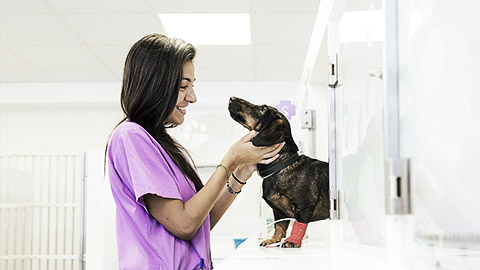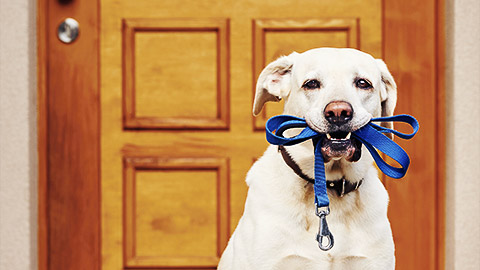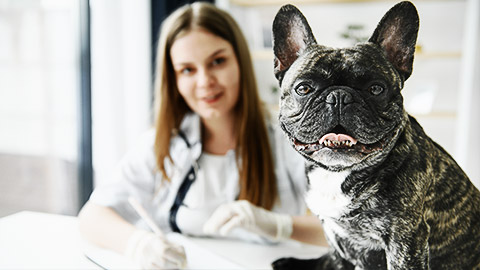Routine tasks carried out in an animal care facility
It is important that as a receptionist/or animal carer working in the reception area, that you carry out any routine tasks to assist with the animal during the appointment or booking. This could include:
- Collecting admission and discharge information
- Documenting items to be kept with animal
- Moving animals to housing or handling area
- Handing animal over to other staff or returning to client
- Fitting collars, head collars, leads and/or Clothing
- Measuring size for clothing or other items
- Weighing an animal
- TPR – (Temperature, Pulse/Heart Rate, Respiratory Rate)
- Restraining the animal to carry out an examination, take blood or give injections
- Holding the animal for nail trims
Weighing an animal
This should be done every time the animal comes into the facility and updated on their record. An animals weight can fluctuate and it is important to have an updated weight on record for several reasons. These include:
- Feeding requirements
- If the animal is boarding, the correct weight is required to determine the appropriate amount of food to provide for the animal.
- Medical requirements
- If an animal requires worming and flea treatment, you must know their weight to ensure you are giving them the correct dose. You do not want to under or over dose the animal.
- Animal welfare
- If an animal looks skinny or you notice a weight drop, you can check the record to confirm its weight at each appointment. This could help determine if there is a medical issue.
Moving an animal to a treatment or holding area

When moving animals from one area to another, appropriate restraint must be used. This will prevent any potential injuries or the animal from escaping. A secure lead or transport housing should be used. Even if you are holding an animal in your arms, you should still have a lead secured.
Handing an animal over to a client or another staff member
It is important that you communicate with clients and staff members. If you are handing over to another staff member at the end of your shift, you should always give them details about the animal and a run down on the reason for their stay at the facility.
When you are handing an animal back to a client, you should always make sure you communicate any important information.
When you are carrying out any of these tasks, it is important that you follow the facilities instruction as well as the clinic's policies and procedures for handling animals.
If you have any doubts about handling an animal, make sure that you ask someone. It is important that you handle the animals with care as well as with confidence as the animals will pick up on any stress or anxiety that you have and can react negatively to these feelings. Animals are very perceptive and if they feel in any way that you are not confident, they could act out giving problems or even attempting to escape for restraint.

Effective restraint is one of those aspects of animal handling that we simultaneously take for granted but also wish we could do better. Restraint techniques are passed on in an almost cultural fashion with little thought given to their logic and effectiveness. Historically, animals were restrained by physically overpowering them. This often resulted in injury to the animal or involved personal injury to the handler. Often the restraint attempt fails, preventing successful completion of the intended procedure.
Animal restraints may include:
- Muzzles, collars, halters and head collars
- Rearing bits, twitch or hobbles (used on horses)
- Leads
- Holding cages
- Physical holds using hands, gloves
- Equipment (e.g., Towels or bags)
Note: this unit excludes chemical restraints
Good restraint is about empathy, finesse, and technique
Good restraint has little to do with strength. Choosing techniques that build on natural behavioural responses result in a greater likelihood of success. This approach also encourages increased empathy and awareness of the animal as an emotional and sentient being. Safety and success are much more likely when you strive to reduce actions that the animal may view as threatening or aggressive. Adversarial handling typically increases the probability of the animal becoming aggressive or attempting to escape.
A number of factors are involved in triggering aggression and/or escape responses in animals. In laboratory settings, restraint stress has long been used as a way to study acute and chronic stress responses in animals.
In an animal care setting, the most common actions or interactions that prompt aggressive responses include fear, pain, and excessive physical restraint. Most animals show fear/defensive aggression because they find some aspect of the process threatening. This may be the environment, the personnel, the equipment, the procedure, the restraint technique used or any combination of these. The determination as to whether something is aversive or painful to an animal is based on the animal's response, not on the opinion of the staff or veterinarian.
Often, in the process of trying to be friendly to an animal, we portray body signals that actually mean the opposite. The way the average person greets a dog is a perfect example. Most people approach dogs from the front, lean over, and extend their hand to allow the dog to sniff it or to try to pet the dog. There are several elements in this approach that directly threaten the dog: the direct, frontal approach; making eye contact; leaning over; and reaching out over the dog's head. These are intensified if they are done in a quick, tense or agitated manner. 2
Basic reactions
Animals have 5 basic reactions to stress or threat – the five "F's":
- Fight
- Flight
- Freeze
- Faint
- Fidget (or fooling around)
The latter is an often-overlooked sign of stress. Staff members frequently assume animals that are obnoxious and hyper in the room are just plain stupid or untrained, but this is a simplistic outlook considering the situation the animal is in.
Keep open minded that the animal's hyperactivity might actually be a reaction to stress. Punishing these animals usually raises their stress level and exacerbates the behaviour.3
Professionalism and safety in animal handling and restraint
When clients and their pets come into your facility there will be times that you will have to assist with restraining and handling animals: it is important to remember that:
- The owners will be watching you to learn how to properly handle animals
- Being professional means being SAFE and HUMANE
- Good animal handling skills prevent staff from being injured
- Good animal handling skills reduce stress for the animal
Examples of safe animal handling:
It is important that you:
- Be aware of the stressors for animals in the environment
- An animal care facility is extremely chaotic for any animal. There are an incredible number of smells, and other stimuli and animals are likely to be confused and distressed
- Many animals have lived entirely outdoors and have not been handled or examined before. They may not have any experience on a leash and may panic in response
- Even the most social animal may exhibit aggression toward other animals, particularly in a strange environment and may redirect that behaviour to nearby people when over-stimulated
- Never put your face directly into the face of a dog or cat
- Do not move in behind or crowd around a dog
- Concentrate on the animal you are handling without being distracted by other activities
- NEVER sit on the floor while handling/examining a dog. If the animal becomes aggressive or aroused, you will be unable to move away or protect yourself and risk serious facial bites
- Always be prepared to protect yourself or move away quickly in the event an animal becomes aggressive unexpectedly
Safe and effective animal handling requires a thorough understanding of the normal behaviour and responses of each species. Below is some general information on animal behaviour and handling techniques.
There is no substitute, however, for careful observation and experience.
If there is any doubt about the temperament of an animal - ASK FOR ASSISTANCE. 4
There are no extra points for being a 'hero'. The safety of staff and other animals are most important!
Communication
Any animal exhibiting potentially aggressive behaviour should have a “WATCH” sign or “CAUTION’ posted to alert other staff members who may be handling the animal. Specific alerts or recommendations should be written on the sign and in the animal’s record to provide staff with as much information as possible in relation to handling the animal.
Restraint or control
The most important thing to keep in mind when handling any kind of animal is
The least restraint is often the best restraint
This does not mean that you lose control, more importantly, you use as little restraint as necessary while maintaining control of the situation. Every animal and every situation are different, so there are no hard and fast rules as to what method works best in which situation.
Before you attempt to restrain any animal, you should take a few minutes so as to allow the animal to become comfortable with you, and the facility, it will help if you:
- Crouch down so that you are on their level. Do not sit on the ground as you will be unable to move away or protect yourself if necessary
- Avoid crouching over the animal as some can take this as a form of aggression
- Avoid direct eye contact but maintain safe visual contact with the animal
- Talk in soothing tones. Avoid high-pitched, excited talk
- Try patting your leg or the ground, motioning the animal towards you
Types of restraint

Verbal restraint:
Many dogs know some commands or can at least recognise authority, even if the command is unfamiliar.
Commands such as SIT, STAY, COME, DOWN, NO or even HEEL may be useful tools to encourage a dog to cooperate. Also, soft, quiet words can calm a frightened animal. Yelling or screaming should never be used as it can cause the animal to become more fearful or aggressive.5
Physical restraint: tools and equipment
Leash:
The most common tool used to handle animals is the leash. Placed around a dog's neck, it normally controls even the largest dog. In the event a dog refuses to cooperate with a leash, it might be advisable (if possible) to carry him. Some dogs have never seen a leash and will freeze up to the sensation around a sensitive area like the neck.
- Remember that leashes should not be abused; never drag or strangle an animal with a leash. It is very important that you stay calm and take time to pause and let the dog calm down and try again after reassuring her. Sometimes a quick tug on the leash will encourage a fearful dog to walk. If the dog refuses to walk, apply a muzzle (if necessary) and carry them (if possible).
- It is VERY IMPORTANT that you remember that every animal being transported or handled in the facility must ALWAYS wear a slip-lead. This includes puppies, cats and sedated animals. It is far too easy for a frightened animal to get loose and escape. If an animal is coming into hospital or day stay, the animal that comes into your clinic with their owner, who is on collar and leash should be transferred to a slip lead, and the leash returned to the client so that it is not lost during the animal’s stay.
Your hand:
- Your hands are a very effective form of restraint; your hands are sensitive to the amount of pressure that you can exert on the animal so that you can quickly modify your grip on the situation. Hands can also be used to gently stroke a dog or to firmly grasp a struggling cat. Although hands can be very versatile, they are also the most vulnerable to injury, so remember to take care when you are handling animals. Recognising when they would not be effective is also very important.
Towels:
- A towel or blanket is a very useful tool for restraining cats and small dogs. A towel can be used to decrease an animal’s movement as well as reducing their arousal by covering the head and body and can help protect from their sharp claws.
Nets:
- The net is the primary tool used to handle fractious cats or wildlife. It allows for the safe handling and transfer of even the most aggressive small mammal. Effective use of the net requires some training and practice. If you need to handle a feral or fractious cat, ask for assistance from a staff member.7
EZ-Nabbers:
- EZ Nabbers Ensure the safety for animal handlers, providing a safe and humane way to capture animals, aseptic intramuscular injections of tranquillizers, anaesthetics and vaccines can be given through the net. Pets can be transferred from one cage to another without injury or stress to the animal or the clinic's staff. Pets can be removed from and/or placed in pet carriers. When the net becomes soiled, leave it on the frame and wash it in the tub with soap and water: use a disinfectant if needed. Abscesses and wounds can be flushed, and the pet can be bathed in the net. 8
Muzzles:
- Muzzles are used when dealing with snappy or potentially aggressive dogs. There are a number of the type these include nylon muzzles and plastic basket available. A leash or strip of rolled gauze can be used as a temporary muzzle. Because dogs often try to remove a muzzle, it is important that the muzzle is placed on the animal securely.
- A weak or poorly made muzzle may lead to a false sense of security and the possibility of being bitten. Even with a securely placed muzzle, appropriate handling must be used to prevent injury from an animal who resists.
- Muzzles designed for cats extend up to cover the eyes, reducing visual stimulation. For some cats, these can be very useful for calming the animal and helping to protect the handler from injury,
Drugs:
- When an animal who is aggressive or is very stressed and able to be handled safely for procedures, sedation and/or general anaesthesia, or allow treatment. It is important that if you are unable to handle an animal, notify a staff member to determine whether sedation is appropriate.
- When receiving an animal for surgery who exhibits difficult or aggressive behaviour consult the Anaesthesia Lead prior to kennelling the animal as we may opt to administer a pre-anaesthetic sedative immediately and expedite the surgery process to minimize the animal’s time in the clinic.
The place where correct use of restraint is the most critical is when two people are handling the animal.
This could be to perform a physical exam, administer an anaesthetic or to give medications.
The "holder" is the person whose job it is to restrain the animal in such a way that the procedure can be accomplished with the least amount of stress to both handlers and animal. The specific amount of restraint used to control the animal is the key to safety for the handlers and comfort for the animal.
Too much restraint can cause the animal to fight back, too little restraint can result in the handler or others being injured or in the animal escaping9

Updating clients
Throughout the day you will interact with clients and give them updates on their animals who are in the facility. You might update a client if:
- An animal is boarding
This could be a simple photo sent to the client, a text message or a phone call to let them know their animal is okay. - An animal is ready to go home after a service has been provided
You may need to call an owner to let them know that their animal is ready to be picked up.
Reporting on animal welfare
If you believe an animal requires veterinary attention or you have concerns about an animal, you should report this directly to your supervisor.

It is very important that any interaction with the clients and their pet is documented in accordance with your clinic's policies and procedures.
Most documentation is written in the client’s files which are contained on a computer system such as vet link.
Interaction with clients may include:
- Inquiries about products and services:
- Telephone or face to face
- Email or internet
- Collecting payments
- Advising of problems with payments
- Dealing with initial complaints about products, service or staff
- Dealing with distressed clients
- Instructions from clients about products and services required
- Providing information within the limits of business policy and personal responsibility
- Referring clients to senior staff
- Reporting on animal welfare or progress
- Relaying potentially upsetting news
Some interaction with clients and their pets can be in the form of a written proformas, such as:
- Boarding consent
- Grooming consent
- Anaesthesia Record
- Hospital treatment sheet
- New clients form
- Blood sample forms
- Admission forms
- Animal histories
- Vaccination records
These forms can be transferred to the computer system. At all times information must be documented in accordance with the clinic's policies and procedures.

